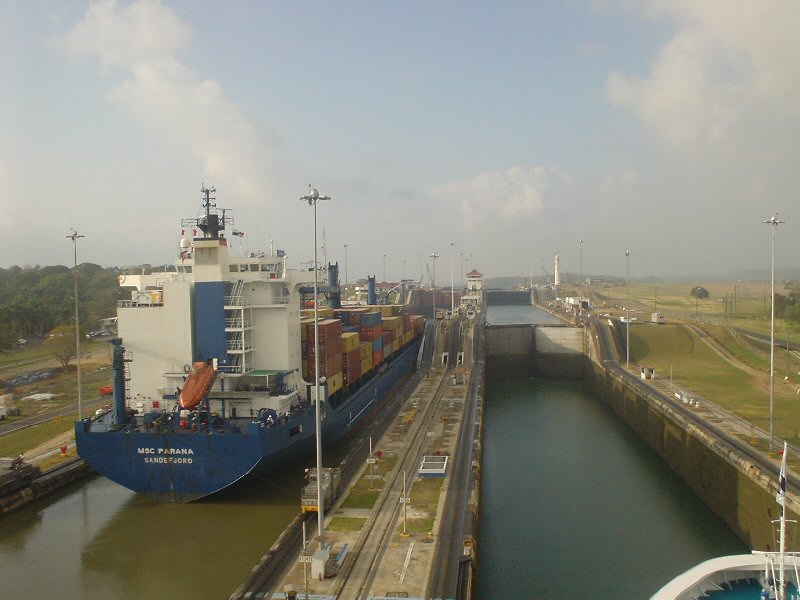Theodore Roosevelt wrote in his autobiography:
By far the most important action I took in foreign affairs during the time I was President was related to the Panama Canal.
It was first proposed by Spain as early as 1534 so as to not have to sail around the Strait of Magellan.
France began building a sea-level canal in 1880, led by Ferdinand de Lesseps, builder of the Suez Canal.
France abandoned the effort because of landslides from heavy seasonal rains and tropical diseases of malaria and yellow fever, which killed 25,000.
After the Spanish-American War, Dr. Walter Reed of the U.S. Army researched in Cuba in 1899 and confirmed the discovery of Dr. Carlos Finlay — that malaria and yellow fever were carried by mosquitoes.
With this knowledge, public sanitation measures were developed which made construction of a canal in Panama more attainable.
In 1903, the United States helped Panama gain its independence from Columbia.
The U.S. purchased the Canal Zone from Panama for $10 million, plus annual payments of $250,000.
The Panama Canal was planned by President William McKinley, with the actual construction beginning under President Theodore Roosevelt.
Instead of a straight sea-level canal, Roosevelt favored a key design change: have a set of three locks rise from sea-level to a lake, then on the other side of the lake have three locks going back down to sea level.
On December 17, 1906, President Roosevelt addressed Congress:
The Isthmus had been a by-word for deadly unhealthfulness.
Now, after two years of our occupation the conditions as regards sickness and the death rate compare…with reasonably healthy localities in the United States.
Especial care has been devoted to minimizing the risk due to the presence of those species of mosquitoes which have been found to propagate malarial and yellow fevers.
For the construction of the canal, inventions were made, such as railroads, steam shovels, steam-powered cranes, hydraulic rock crushers, cement mixers, dredges, pneumatic power drills, and electric motors.
This technology, largely developed and built in the United States, was used to create the largest dam and the largest man-made lake in the world at that time — Gatun Lake.
On December 6, 1912, President William Taft addressed Congress:
Our defense of the Panama Canal, together with our enormous world trade and our missionary outposts on the frontiers of civilization, require us to recognize our position as one of the foremost in the family of nations, and to clothe ourselves with sufficient naval power to give force to our reasonable demands, and to give weight to our influence in those directions of progress that a powerful Christian nation should advocate.
On October 23, 1913, President Woodrow Wilson stated in his Thanksgiving Proclamation:
We have seen the practical completion of a great work at the Isthmus of Panama which not only exemplifies the nation’s abundant capacity of its public servants but also promises the beginning of a new age of co-operation and peace.
“Righteousness exalteth a nation” and “peace on earth, good will towards men” furnish the only foundation upon which can be built the lasting achievements of the human spirit.
The Panama Canal was opened August 15, 1914, the same year World War I began. Within 10 years, more than 5,000 ships a year were passing through the Panama Canal.
The largest American engineering project to that date, it had cost the United States $375,000,000 (roughly $10 billion today).
The Panama Canal also cost 5,600 American lives.
On March 31, 1976, then-California Governor Ronald Reagan stated:
Well, the Canal Zone is not a colonial possession. It is not a long-term lease. It is sovereign United States Territory every bit the same as Alaska and all the states that were carved from the Louisiana Purchase…
We bought it, we paid for it, we built it, and we intend to keep it.
Democrat President Jimmy Carter gave away the Panama Canal in 1977.
Today, passage through the ports at either end of the Panama Canal (Balboa and Cristobal) is effectively controlled by the Chinese company Huchinson Port Holding, which will open a new set of locks in 2016 allowing for larger ships.
Hutchison Port Holding is the world’s largest seaport operator, running strategic seaports in Argentina, Bahamas, Mexico, China, Hong Kong, Indonesia, Korea, Malaysia, Myanmar, Pakistan, Thailand, Vietnam, Australia, Belgium, Germany, Italy, Poland, Spain, Sweden, The Netherlands, United Kingdom, Egypt, Oman, Saudi Arabia, Tanzania, and UAE.
